Multi-Year Monitoring of Deciduous Forests Ecophysiology and the Role of Temperature and Precipitation as Controlling Factors
Abstract
:1. Introduction
2. Materials and Methods
2.1. Study Sites
2.2. Field Measurements
2.3. Meteorological Data
2.4. Statistics
3. Results
3.1. Leaf Area Index
3.2. Chlorophylls
3.3. Leaf Specific Mass
3.4. Water Potential
3.5. Photosynthesis
3.6. Climatic Control
4. Discussion
4.1. LAI
4.2. Chlorophylls and LSM
4.3. Water Potential
4.4. Photosynthesis
4.5. Climatic Control on LAI, Chlorophylls and LSM
4.6. Climatic Control on Ψ and Photosynthesis
4.7. Species Differences in Sensitivity to Climate
5. Conclusions
Author Contributions
Funding
Institutional Review Board Statement
Informed Consent Statement
Data Availability Statement
Conflicts of Interest
References
- Colangelo, M.; Camarero, J.J.; Gazol, A.; Piovesan, G.; Borghetti, M.; Baliva, M.; Gentilesca, T.; Rita, A.; Schettino, A.; Ripullone, F. Mediterranean Old-Growth Forests Exhibit Resistance to Climate Warming. Sci. Total Environ. 2021, 801, 149684. [Google Scholar] [CrossRef] [PubMed]
- Leuschner, C. Drought Response of European Beech (Fagus sylvatica L.)—A Review. Perspect. Plant Ecol. Evol. Syst. 2020, 47, 125576. [Google Scholar] [CrossRef]
- Mariën, B.; Dox, I.; De Boeck, H.J.; Willems, P.; Leys, S.; Papadimitriou, D.; Campioli, M. Does Drought Advance the Onset of Autumn Leaf Senescence in Temperate Deciduous Forest Trees? Biogeosciences 2021, 18, 3309–3330. [Google Scholar] [CrossRef]
- Meier, I.C.; Leuschner, C. Leaf Size and Leaf Area Index in Fagus sylvatica Forests: Competing Effects of Precipitation, Temperature, and Nitrogen Availability. Ecosystems 2008, 11, 655–669. [Google Scholar] [CrossRef]
- Prislan, P.; Gričar, J.; de Luis, M.; Smith, K.T.; Čufar, K. Phenological Variation in Xylem and Phloem Formation in Fagus sylvatica from Two Contrasting Sites. Agric. For. Meteorol. 2013, 180, 142–151. [Google Scholar] [CrossRef]
- Piovesan, G.; Biondi, F.; Filippo, A.D.; Alessandrini, A.; Maugeri, M. Drought-Driven Growth Reduction in Old Beech (Fagus sylvatica L.) Forests of the Central Apennines, Italy: Drought-Driven Growth Decline in Beech Forests. Glob. Chang. Biol. 2008, 14, 1265–1281. [Google Scholar] [CrossRef]
- Stojnić, S.; Suchocka, M.; Benito-Garzón, M.; Torres-Ruiz, J.M.; Cochard, H.; Bolte, A.; Cocozza, C.; Cvjetković, B.; de Luis, M.; Martinez-Vilalta, J.; et al. Variation in Xylem Vulnerability to Embolism in European Beech from Geographically Marginal Populations. Tree Physiol. 2018, 38, 173–185. [Google Scholar] [CrossRef]
- Fotelli, M.N.; Nahm, M.; Radoglou, K.; Rennenberg, H.; Halyvopoulos, G.; Matzarakis, A. Seasonal and Interannual Ecophysiological Responses of Beech (Fagus sylvatica) at Its South-Eastern Distribution Limit in Europe. For. Ecol. Manag. 2009, 257, 1157–1164. [Google Scholar] [CrossRef]
- Cavin, L.; Jump, A.S. Highest Drought Sensitivity and Lowest Resistance to Growth Suppression Are Found in the Range Core of the Tree Fagus sylvatica L. Not the Equatorial Range Edge. Glob. Chang. Biol. 2017, 23, 362–379. [Google Scholar] [CrossRef]
- Kasper, J.; Leuschner, C.; Walentowski, H.; Petritan, A.M.; Weigel, R. Winners and Losers of Climate Warming: Declining Growth in Fagus and Tilia vs. Stable Growth in Three Quercus Species in the Natural Beech–Oak Forest Ecotone (Western Romania). For. Ecol. Manag. 2022, 506, 119892. [Google Scholar] [CrossRef]
- Peñuelas, J.; Hunt, J.M.; Ogaya, R.; Jump, A.S. Twentieth Century Changes of Tree-Ring δ 13 C at the Southern Range-Edge of Fagus sylvatica: Increasing Water-Use Efficiency Does Not Avoid the Growth Decline Induced by Warming at Low Altitudes: BEECH δ 13 C UNDER GROWTH DECLINE. Glob. Chang. Biol. 2008, 14, 1076–1088. [Google Scholar] [CrossRef]
- Nahm, M.; Radoglou, K.; Halyvopoulos, G.; Geßler, A.; Rennenberg, H.; Fotelli, M.N. Physiological Performance of Beech (Fagus sylvatica L.) at Its Southeastern Distribution Limit in Europe: Seasonal Changes in Nitrogen, Carbon and Water Balance. Plant Biol. 2006, 8, 52–63. [Google Scholar] [CrossRef] [PubMed]
- Jump, A.S.; Hunt, J.M.; Martínez-Izquierdo, J.A.; Peñuelas, J. Natural Selection and Climate Change: Temperature-Linked Spatial and Temporal Trends in Gene Frequency in Fagus Sylvatica: Selection by Climate in Fagus sylvatica. Mol. Ecol. 2006, 15, 3469–3480. [Google Scholar] [CrossRef] [PubMed]
- Schuldt, B.; Buras, A.; Arend, M.; Vitasse, Y.; Beierkuhnlein, C.; Damm, A.; Gharun, M.; Grams, T.E.E.; Hauck, M.; Hajek, P.; et al. A First Assessment of the Impact of the Extreme 2018 Summer Drought on Central European Forests. Basic Appl. Ecol. 2020, 45, 86–103. [Google Scholar] [CrossRef]
- Manes, F.; Vitale, M.; Donato, E.; Giannini, M.; Puppi, G. Different Ability of Three Mediterranean Oak Species to Tolerate Progressive Water Stress. Photosynthetica 2006, 44, 387–393. [Google Scholar] [CrossRef]
- Markos, N.; Kyparissis, A. Ecophysiological Modelling of Leaf Level Photosynthetic Performance for Three Mediterranean Species with Different Growth Forms. Funct. Plant Biol. 2011, 38, 314. [Google Scholar] [CrossRef]
- Michelot, A.; Simard, S.; Rathgeber, C.; Dufrene, E.; Damesin, C. Comparing the Intra-Annual Wood Formation of Three European Species (Fagus sylvatica, Quercus petraea and Pinus sylvestris) as Related to Leaf Phenology and Non-Structural Carbohydrate Dynamics. Tree Physiol. 2012, 32, 1033–1045. [Google Scholar] [CrossRef]
- Kasper, J.; Weigel, R.; Walentowski, H.; Gröning, A.; Petritan, A.M.; Leuschner, C. Climate Warming-Induced Replacement of Mesic Beech by Thermophilic Oak Forests Will Reduce the Carbon Storage Potential in Aboveground Biomass and Soil. Ann. For. Sci. 2021, 78, 89. [Google Scholar] [CrossRef]
- Rubio-Cuadrado, Á.; Camarero, J.J.; del Río, M.; Sánchez-González, M.; Ruiz-Peinado, R.; Bravo-Oviedo, A.; Gil, L.; Montes, F. Drought Modifies Tree Competitiveness in an Oak-Beech Temperate Forest. For. Ecol. Manag. 2018, 429, 7–17. [Google Scholar] [CrossRef]
- Raftoyannis, Y. Physiological Responses of Beech and Sessile Oak in a Natural Mixed Stand During a Dry Summer. Ann. Bot. 2002, 89, 723–730. [Google Scholar] [CrossRef] [Green Version]
- Wolkerstorfer, S.V.; Wonisch, A.; Stankova, T.; Tsvetkova, N.; Tausz, M. Seasonal Variations of Gas Exchange, Photosynthetic Pigments, and Antioxidants in Turkey Oak (Quercus cerris L.) and Hungarian Oak (Quercus frainetto Ten.) of Different Age. Trees 2011, 25, 1043–1052. [Google Scholar] [CrossRef]
- Ripullone, F.; Camarero, J.J.; Colangelo, M.; Voltas, J. Variation in the Access to Deep Soil Water Pools Explains Tree-to-Tree Differences in Drought-Triggered Dieback of Mediterranean Oaks. Tree Physiol. 2020, 40, 591–604. [Google Scholar] [CrossRef] [PubMed]
- Fu, Y.H.; Piao, S.; Delpierre, N.; Hao, F.; Hänninen, H.; Liu, Y.; Sun, W.; Janssens, I.A.; Campioli, M. Larger Temperature Response of Autumn Leaf Senescence than Spring Leaf-out Phenology. Glob. Chang. Biol. 2018, 24, 2159–2168. [Google Scholar] [CrossRef] [PubMed]
- Dox, I.; Gričar, J.; Marchand, L.J.; Leys, S.; Zuccarini, P.; Geron, C.; Prislan, P.; Mariën, B.; Fonti, P.; Lange, H.; et al. Timeline of Autumn Phenology in Temperate Deciduous Trees. Tree Physiol. 2020, 40, 1001–1013. [Google Scholar] [CrossRef]
- Tselepidakis, I.G.; Theoharatos, G.A. A Bioclimatic Classification of the Greek Area. Theor. Appl. Climatol. 1989, 40, 147–153. [Google Scholar] [CrossRef]
- Norman, J.M.; Jarvis, P.G. Photosynthesis in Sitka Spruce (Picea Sitchensis (Bong.) Carr.). III. Measurements of Canopy Structure and Interception of Radiation. J. Appl. Ecol. 1974, 11, 375–398. [Google Scholar] [CrossRef]
- Lichtenthaler, H.K.; Wellburn, A.R. Determinations of Total Carotenoids and Chlorophylls a and b of Leaf Extracts in Different Solvents. Biochem. Soc. Trans. 1983, 11, 591–592. [Google Scholar] [CrossRef]
- Leuschner, C.; Voß, S.; Foetzki, A.; Clases, Y. Variation in Leaf Area Index and Stand Leaf Mass of European Beech across Gradients of Soil Acidity and Precipitation. Plant Ecol 2006, 186, 247–258. [Google Scholar] [CrossRef]
- Parker, G.G. Tamm Review: Leaf Area Index (LAI) Is Both a Determinant and a Consequence of Important Processes in Vegetation Canopies. For. Ecol. Manag. 2020, 477, 118496. [Google Scholar] [CrossRef]
- Mund, M.; Herbst, M.; Knohl, A.; Matthäus, B.; Schumacher, J.; Schall, P.; Siebicke, L.; Tamrakar, R.; Ammer, C. It Is Not Just a ‘Trade-off’: Indications for Sink- and Source-limitation to Vegetative and Regenerative Growth in an Old-growth Beech Forest. New Phytol. 2020, 226, 111–125. [Google Scholar] [CrossRef]
- Packham, J.R.; Thomas, P.A.; Atkinson, M.D.; Degen, T. Biological Flora of the British Isles: Fagus sylvatica. J. Ecol. 2012, 100, 1557–1608. [Google Scholar] [CrossRef]
- Süßel, F.; Brüggemann, W. Tree Water Relations of Mature Oaks in Southwest Germany under Extreme Drought Stress in Summer 2018. Plant Stress 2021, 1, 100010. [Google Scholar] [CrossRef]
- Bréda, N.; Huc, R.; Granier, A.; Dreyer, E. Temperate Forest Trees and Stands under Severe Drought: A Review of Ecophysiological Responses, Adaptation Processes and Long-Term Consequences. Ann. For. Sci. 2006, 63, 625–644. [Google Scholar] [CrossRef]
- Arend, M.; Link, R.M.; Zahnd, C.; Hoch, G.; Schuldt, B.; Kahmen, A. Lack of Hydraulic Recovery as a Cause of Post-drought Foliage Reduction and Canopy Decline in European Beech. New Phytol. 2022, 234, 1195–1205. [Google Scholar] [CrossRef] [PubMed]
- Fu, Y.S.H.; Campioli, M.; Vitasse, Y.; De Boeck, H.J.; Van den Berge, J.; AbdElgawad, H.; Asard, H.; Piao, S.; Deckmyn, G.; Janssens, I.A. Variation in Leaf Flushing Date Influences Autumnal Senescence and next Year’s Flushing Date in Two Temperate Tree Species. Proc. Natl. Acad. Sci. USA 2014, 111, 7355–7360. [Google Scholar] [CrossRef]
- Urban, J.; Bednárová, E.; Plichta, R.; Gryc, V.; Vavrčík, H.; Hacura, J.; Fajstavr, M.; Kučera, J. Links between Phenology and Ecophysiology in a European Beech Forest. iForest 2015, 8, 438–447. [Google Scholar] [CrossRef]
- Witkowski, E.T.F.; Lamont, B.B. Leaf Specific Mass Confounds Leaf Density and Thickness. Oecologia 1991, 88, 486–493. [Google Scholar] [CrossRef]
- Bussotti, F.; Prancrazi, M.; Matteucci, G.; Gerosa, G. Leaf Morphology and Chemistry in Fagus sylvatica (Beech) Trees as Affected by Site Factors and Ozone: Results from CONECOFOR Permanent Monitoring Plots in Italy. Tree Physiol. 2005, 25, 211–219. [Google Scholar] [CrossRef]
- Klein, T. The Variability of Stomatal Sensitivity to Leaf Water Potential across Tree Species Indicates a Continuum between Isohydric and Anisohydric Behaviours. Funct. Ecol. 2014, 28, 1313–1320. [Google Scholar] [CrossRef]
- del Castillo, J.; Comas, C.; Voltas, J.; Ferrio, J.P. Dynamics of Competition over Water in a Mixed Oak-Pine Mediterranean Forest: Spatio-Temporal and Physiological Components. For. Ecol. Manag. 2016, 382, 214–224. [Google Scholar] [CrossRef] [Green Version]
- Vitasse, Y.; Basler, D. What Role for Photoperiod in the Bud Burst Phenology of European Beech. Eur. J. For. Res. 2013, 132, 1–8. [Google Scholar] [CrossRef]
- Signarbieux, C.; Toledano, E.; de Carcer, P.S.; Fu, Y.H.; Schlaepfer, R.; Buttler, A.; Vitasse, Y. Asymmetric Effects of Cooler and Warmer Winters on Beech Phenology Last beyond Spring. Glob. Chang. Biol. 2017, 23, 4569–4580. [Google Scholar] [CrossRef] [PubMed]
- Mund, M.; Kutsch, W.L.; Wirth, C.; Kahl, T.; Knohl, A.; Skomarkova, M.V.; Schulze, E.-D. The Influence of Climate and Fructification on the Inter-Annual Variability of Stem Growth and Net Primary Productivity in an Old-Growth, Mixed Beech Forest. Tree Physiol. 2010, 30, 689–704. [Google Scholar] [CrossRef] [PubMed]
- Vieira, J.; Campelo, F.; Nabais, C. Environment Controls Seasonal and Daily Cycles of Stem Diameter Variations in Portuguese Oak (Quercus faginea Lambert). Forests 2022, 13, 170. [Google Scholar] [CrossRef]
- Dantec, C.F.; Vitasse, Y.; Bonhomme, M.; Louvet, J.-M.; Kremer, A.; Delzon, S. Chilling and Heat Requirements for Leaf Unfolding in European Beech and Sessile Oak Populations at the Southern Limit of Their Distribution Range. Int. J. Biometeorol. 2014, 58, 1853–1864. [Google Scholar] [CrossRef]
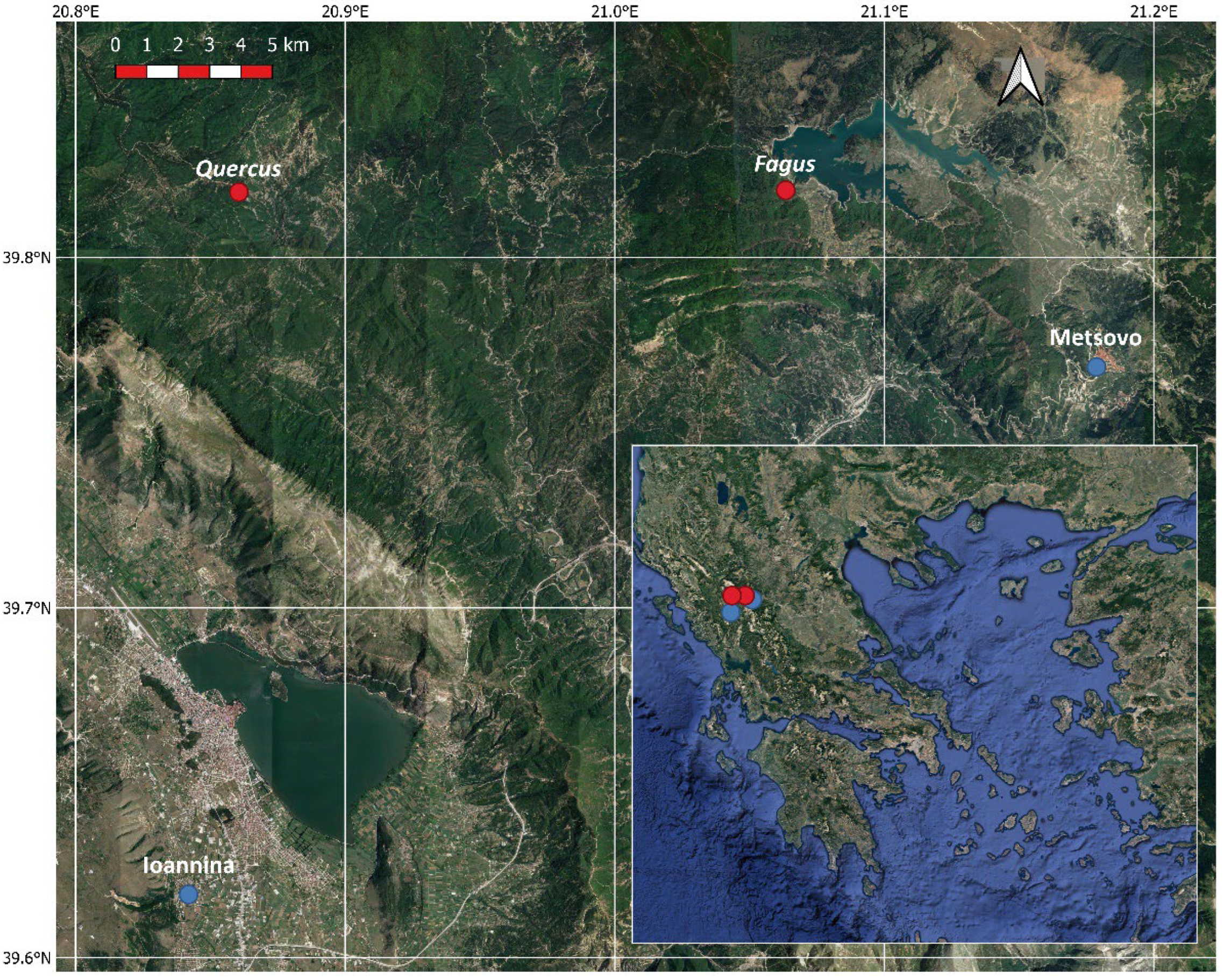


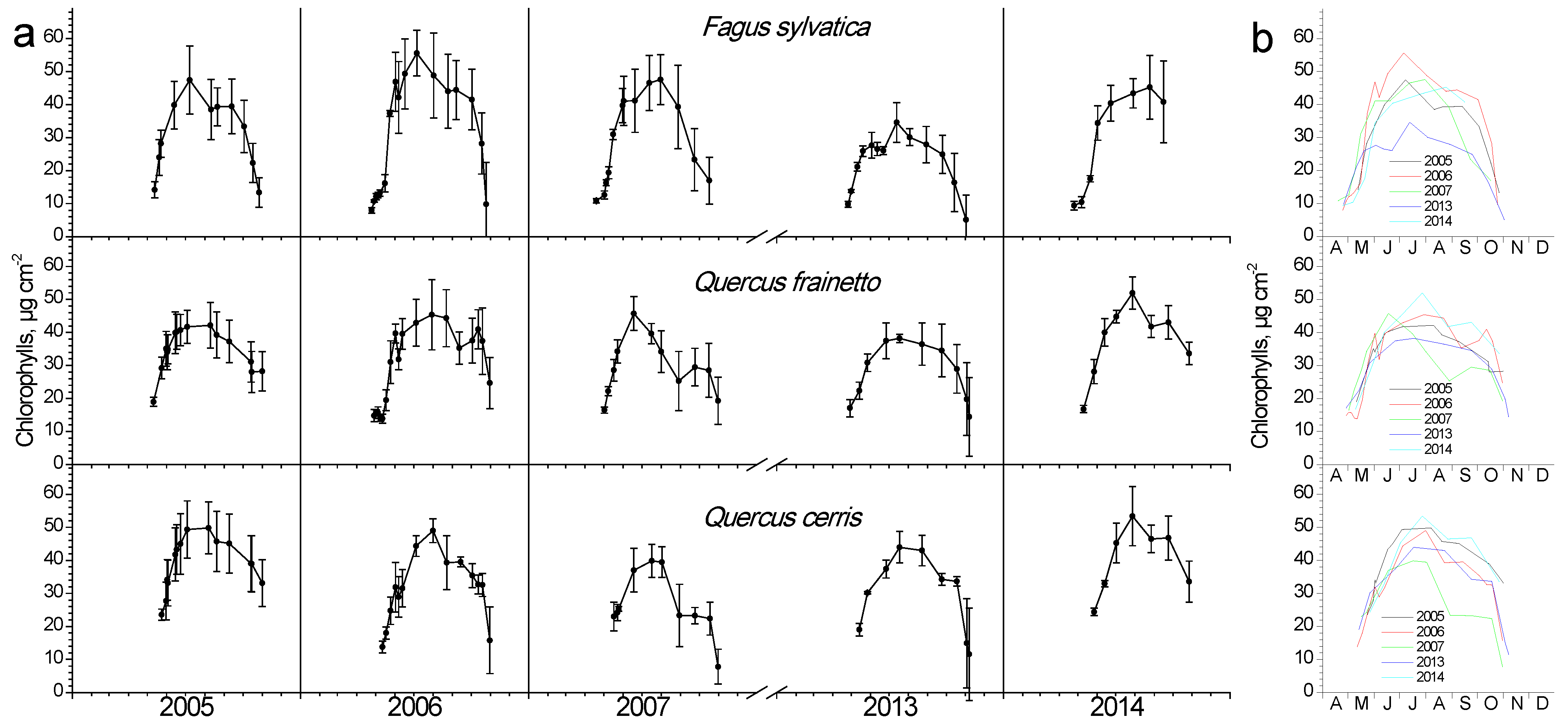
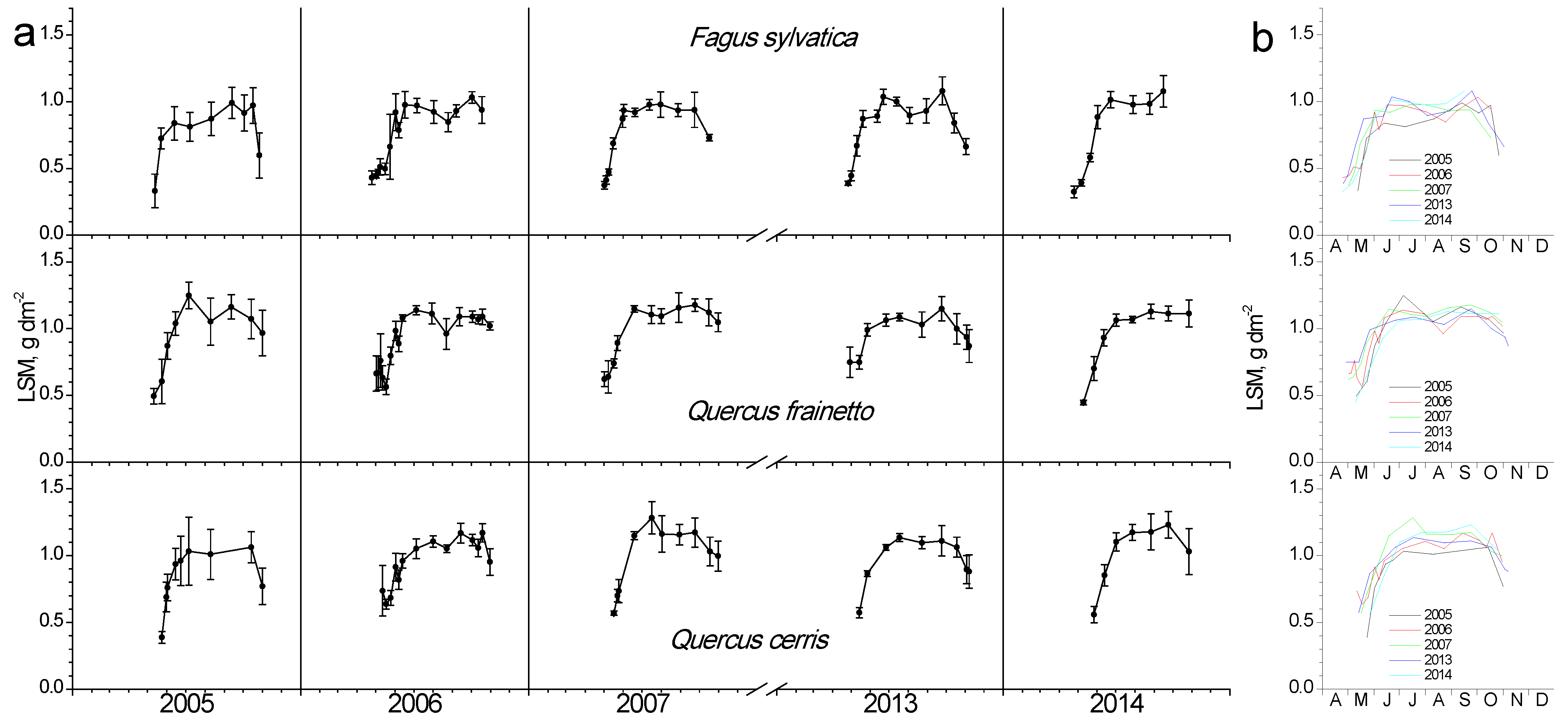
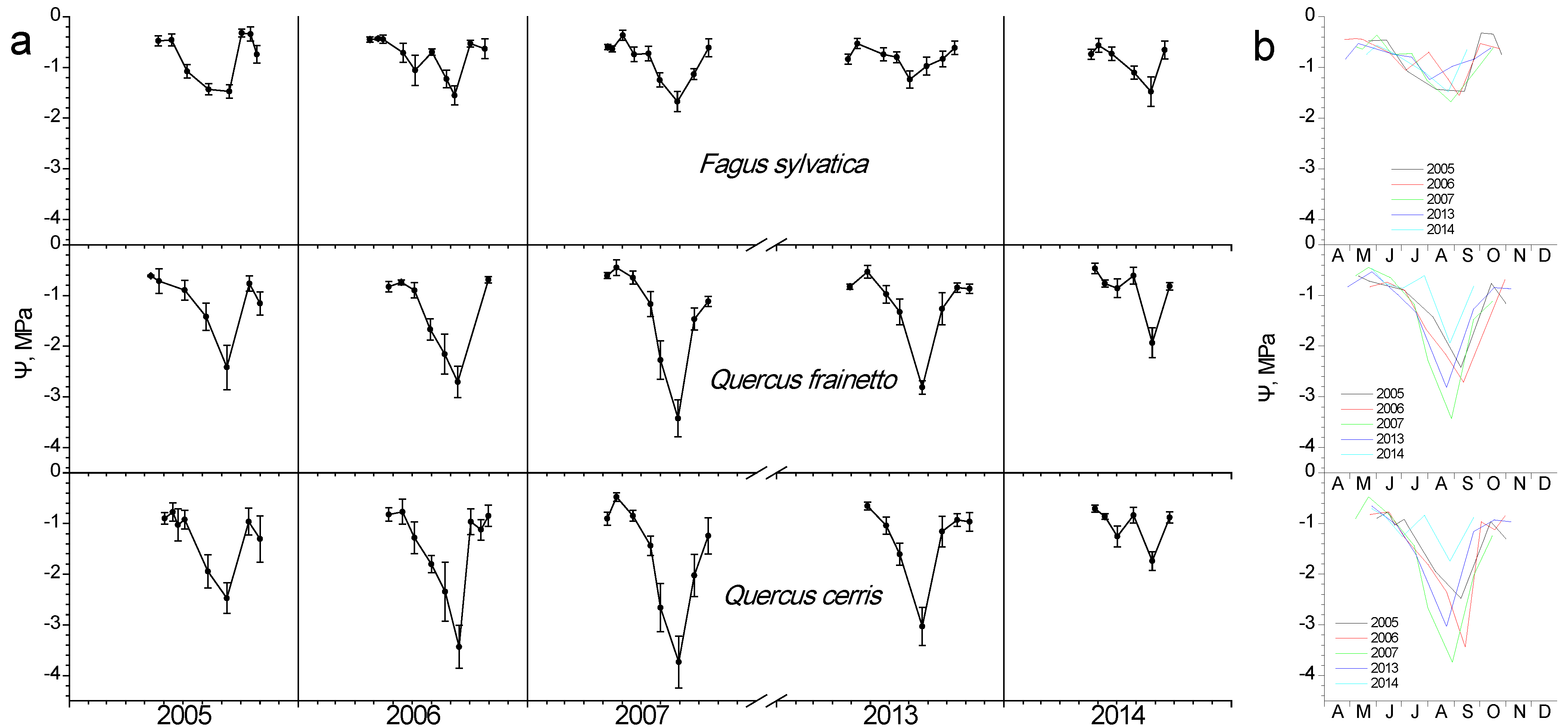

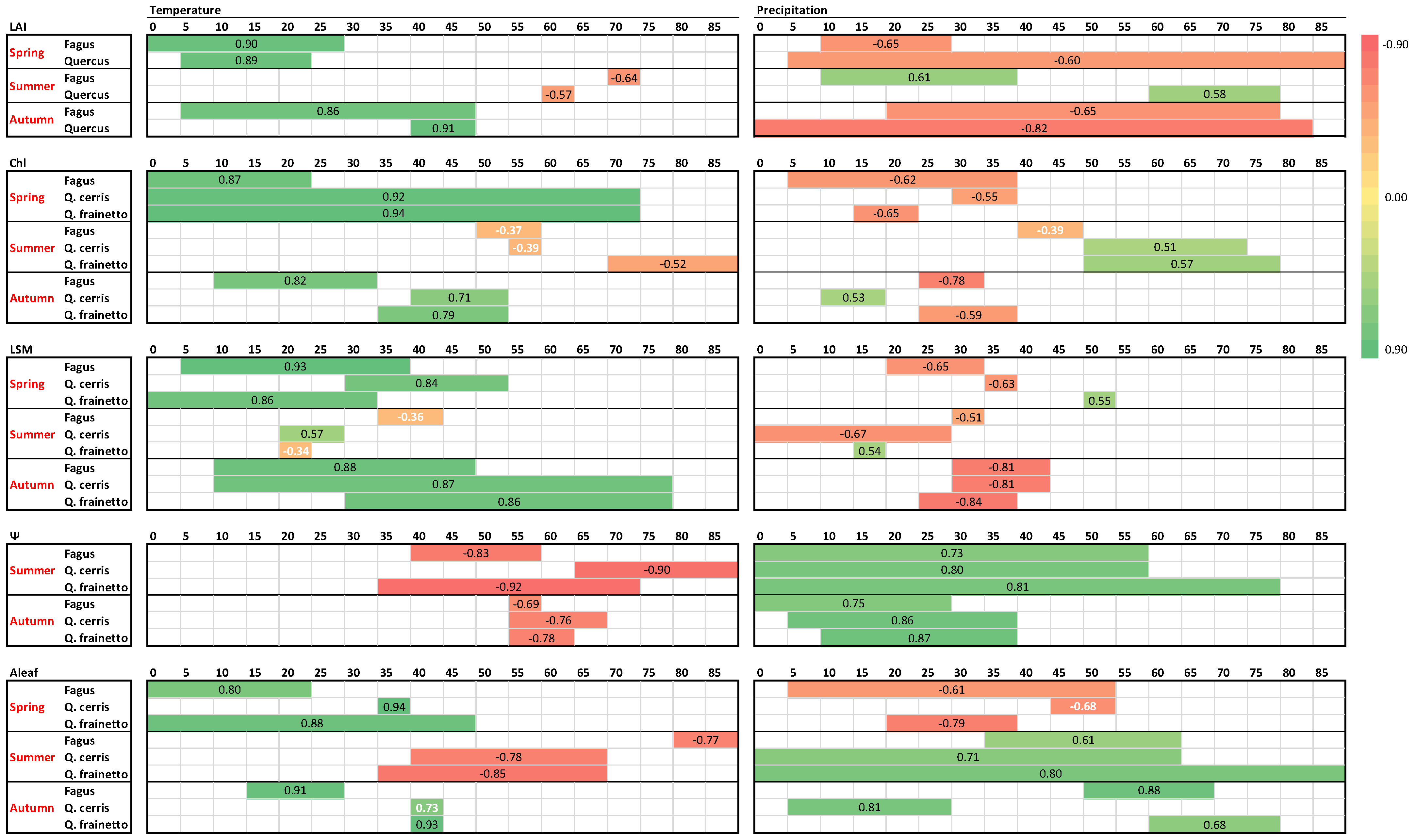
Publisher’s Note: MDPI stays neutral with regard to jurisdictional claims in published maps and institutional affiliations. |
© 2022 by the authors. Licensee MDPI, Basel, Switzerland. This article is an open access article distributed under the terms and conditions of the Creative Commons Attribution (CC BY) license (https://creativecommons.org/licenses/by/4.0/).
Share and Cite
Stagakis, S.; Markos, N.; Vanikiotis, T.; Levizou, E.; Kyparissis, A. Multi-Year Monitoring of Deciduous Forests Ecophysiology and the Role of Temperature and Precipitation as Controlling Factors. Plants 2022, 11, 2257. https://doi.org/10.3390/plants11172257
Stagakis S, Markos N, Vanikiotis T, Levizou E, Kyparissis A. Multi-Year Monitoring of Deciduous Forests Ecophysiology and the Role of Temperature and Precipitation as Controlling Factors. Plants. 2022; 11(17):2257. https://doi.org/10.3390/plants11172257
Chicago/Turabian StyleStagakis, Stavros, Nikos Markos, Theofilos Vanikiotis, Efi Levizou, and Aris Kyparissis. 2022. "Multi-Year Monitoring of Deciduous Forests Ecophysiology and the Role of Temperature and Precipitation as Controlling Factors" Plants 11, no. 17: 2257. https://doi.org/10.3390/plants11172257




